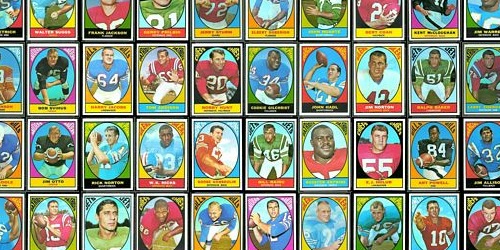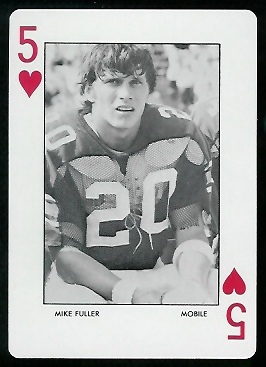November 16th, 2011 |
Published in
Football Card Trivia, Halls of Fame, New in the Gallery
Every wonder how many players in the 1961 Nu-Card college football card set went on to play in the NFL or AFL? I wondered, so I looked them up. I also marked them in the Vintage Football Card Gallery. Before you look, what is your guess? There are a total of 80 cards in the set.
Here’s a hint: it’s at least two. John Hadl played sixteen seasons for the San Diego Chargers, Los Angeles Rams, Green Bay Packers, and Houston Oilers. He is a member of the San Diego Chargers Hall of Fame. Curtis McClinton played eight seasons for the Dallas Texans and Kansas City Chiefs. (The Texans moved to Kansas City and became the Chiefs in 1963.) McClinton is a member of the Chiefs Hall of Fame.
Have your guess? See my 1961 Nu-Card page for the answer.
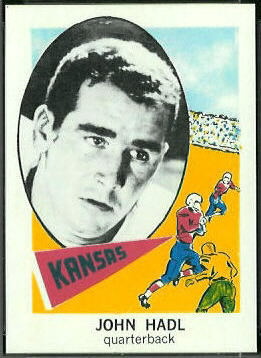
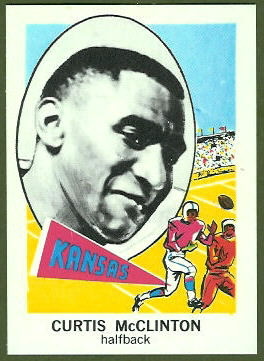
November 13th, 2011 |
Published in
New in the Gallery
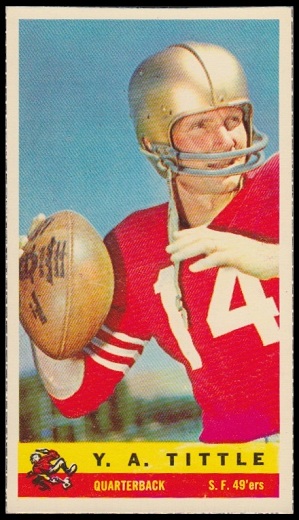 This week I added 1959 Bazooka football cards to the Vintage Football Card Gallery. These cards were hand-cut from the bottoms of boxes of Bazooka bubble gum. Y.A. Tittle, of course, is pictured in his helmet. (As I wrote in an earlier article, Tittle is wearing his helmet on nearly all of his cards.)
This week I added 1959 Bazooka football cards to the Vintage Football Card Gallery. These cards were hand-cut from the bottoms of boxes of Bazooka bubble gum. Y.A. Tittle, of course, is pictured in his helmet. (As I wrote in an earlier article, Tittle is wearing his helmet on nearly all of his cards.)
See the Gallery for more information on the 1959 Bazooka set.
November 9th, 2011 |
Published in
New in the Gallery
This week I added 1972 Auburn Tigers Playing Cards to the Vintage Football Card Gallery. The set is a standard 52-card deck, plus 2 jokers. Fifty-one of the standard cards picture Auburn players, and one, the ace of spades, pictures head coach Ralph “Shug” Jordan. The jokers are Cliff Hare Stadium and Auburn Memorial Coliseum.
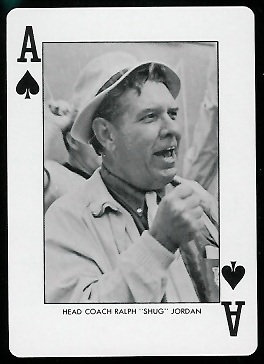
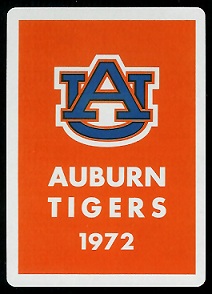
The 1972 Auburn team finished 10-1 and was ranked #5 in the country in the final AP poll. 1972 was also the season of the famous “Punt, ‘Bama, Punt” game, in which Auburn beat Alabama 17-16 by blocking two punts in the fourth quarter and returning them for touchdowns. Bill Newton, who blocked both punts, and David Langner, who returned both of them for touchdowns, are included in the deck of playing cards.
Though Auburn had a great season in 1972, I counted only five players in the deck who went on to play in the NFL. (By contrast, fifteen players in the deck of 1974 Colorado Buffaloes playing cards got playing time in the NFL, and the 1974 Buffs finished just 5-6.) Here are the Auburn players who saw NFL action:
The 1972 Auburn Tigers set is one of several decks of 1970s playing cards that picture players from college teams. For more, see my earlier blog article, “P is also for Playing Cards.”
October 22nd, 2011 |
Published in
New in the Gallery
Yesterday I added a virtual uncut sheet of 1964 Philadelphia football cards to the Vintage Football Card Gallery. I modeled the virtual sheet after a real one that is for sale in an upcoming auction. Thanks to Steve of the thecowboysguide.com for pointing out the auction.
Whereas 1965, 1966, and 1967 Philadelphia sheets appear to have had the same card numbering scheme, the 1964 Philadelphia sheet is numbered differently. On the 1964 sheet, groups of five to ten teammates appear on consecutive cards in the same row. I suspect that this caused a lot of teammates to appear together in packs, and that’s why Philadelphia changed their numbering scheme in 1965 to one that appeared more random.
(Click on the image to see the full virtual sheet.)
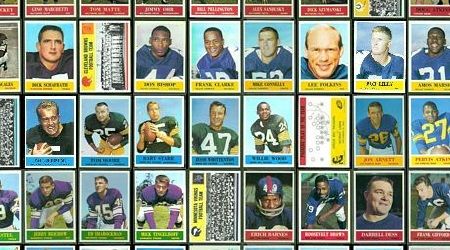
October 16th, 2011 |
Published in
New in the Gallery
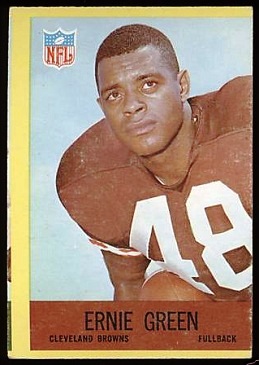 As I have said in previous posts, I have concluded that uncut 1965, 1966, and 1967 Philadelphia football card sheets all had the same card numbering scheme. Thus, from a picture of a 1966 Philadelphia half-sheet, I was able to assemble virtual half-sheets of 1965, 1966, and 1967 Philadelphia cards. Of course, I would also like to assemble the second half-sheet for each set, but I haven’t yet seen an example of a real one. So I started collecting badly miscut cards from the three sets, in hopes of piecing together the second half-sheet. For example, by looking at the miscut Ernie Green card shown here, I can tell that the card to its left was Ben McGee, and I can conclude that cards 154 and 41 were adjacent on the sheets for all three Philadelphia sets.
As I have said in previous posts, I have concluded that uncut 1965, 1966, and 1967 Philadelphia football card sheets all had the same card numbering scheme. Thus, from a picture of a 1966 Philadelphia half-sheet, I was able to assemble virtual half-sheets of 1965, 1966, and 1967 Philadelphia cards. Of course, I would also like to assemble the second half-sheet for each set, but I haven’t yet seen an example of a real one. So I started collecting badly miscut cards from the three sets, in hopes of piecing together the second half-sheet. For example, by looking at the miscut Ernie Green card shown here, I can tell that the card to its left was Ben McGee, and I can conclude that cards 154 and 41 were adjacent on the sheets for all three Philadelphia sets.
The cards I have so far are toward the bottom of my Uncut Sheets in Progress page. If you have any badly miscut cards that could help the cause, please send me some scans!
October 9th, 2011 |
Published in
New in the Gallery
Yesterday I added a virtual uncut sheet of 1965 Philadelphia football cards to the Vintage Football Card Gallery. I have not seen an actual 1965 Philadelphia uncut sheet, but by looking at badly miscut cards, I have concluded that 1965, 1966, and 1967 Philadelphia sheets all had the same numbering scheme. I have seen a picture of a 1966 sheet, and I used it to construct the 1965 virtual sheet.
Each of the 1964-1967 Philadelphia sets contains 66 double prints, though I have not seen the double prints documented in any of the price guides. The 1965 Philadelphia virtual sheet shows which cards are double prints.
(Click on the image to see the full virtual sheet.)
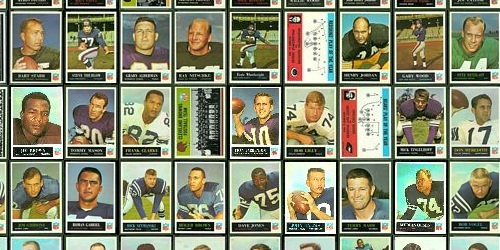
October 8th, 2011 |
Published in
Interactive Team Cards, New in the Gallery, Player Deaths, Record Holders
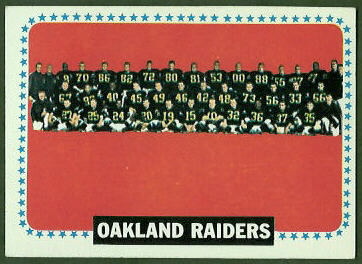 In honor of Al Davis, who passed away today, I added an interactive 1964 Topps Oakland Raiders team card to the Vintage Football Card Gallery. The card pictures the 1963 Raiders team, which Davis coached to a 10-4 record. That was the Raiders’ first winning season, and Davis was named the AFL Coach of the Year.
In honor of Al Davis, who passed away today, I added an interactive 1964 Topps Oakland Raiders team card to the Vintage Football Card Gallery. The card pictures the 1963 Raiders team, which Davis coached to a 10-4 record. That was the Raiders’ first winning season, and Davis was named the AFL Coach of the Year.
As always, I learned a few things while assembling the interactive card. One thing I learned is that one of the players pictured, Tom Morrow, holds the NFL record for most consecutive games with an interception. As far as I know, Morrow never appeared on a card by himself.
(Click on the card image shown here to go to the interactive version.)
September 30th, 2011 |
Published in
New in the Gallery
Yesterday I added a virtual uncut sheet of 1967 Philadelphia football cards to the Vintage Football Card Gallery. I have not seen an actual uncut sheet, but by looking at badly miscut cards, I concluded that 1967 Philadelphia sheets were numbered like 1966 Philadelphia sheets. I have seen a picture of a 1966 sheet, so I used it to construct the 1967 virtual sheet.
Like the 1966 Philadelphia set, the 1967 Philadelphia set contains 66 double prints, but they are not documented in the price guides. The virtual sheet shows which cards are double prints.
(Click on the image to see the full sheet.)
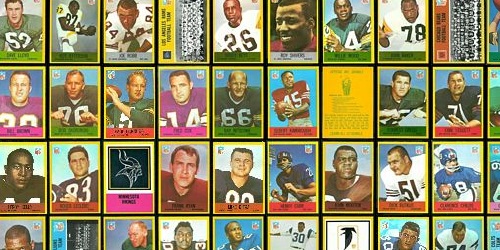
August 26th, 2011 |
Published in
New in the Gallery
Yesterday I added virtual uncut sheets of 1963 Topps cards to the Vintage Football Card Gallery. I have not seen an actual 1963 Topps sheet, but I was able to figure out the sheets’ configuration by looking at miscut cards and applying a little logic. Unfortunately, these sheets are not yet completely accurate, and I could use your help. I believe I have all of the player cards in the right places, but I have not yet figured out the order of the team cards and checklists within their rows. If you happen to find any badly miscut team cards, checklists, or neighboring cards, please send me pictures of them.
With these sheets I introduced a new feature: I started highlighting the cards that are scarcest in high grades. This helps illustrate how a card’s position on the sheet affects its availability. As I have time, I will go back and do this for the other sheets, as well.
(Click on the image to see the full sheets.)
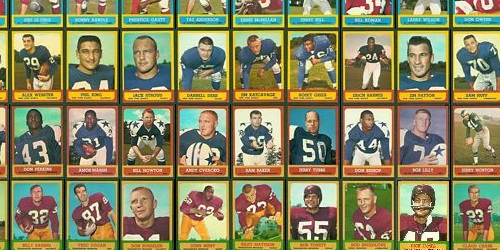
August 23rd, 2011 |
Published in
New in the Gallery
Last night I added a virtual partial uncut sheet of 1967 Topps cards to the Vintage Football Card Gallery. I modeled it after a proof sheet I found in an internet search. For now the partial sheet is on my Sheets In Progress page. At some point I will move it to a page of its own.
One bit of trivia: the cards in the bottom row of the partial sheet also appeared in Milton Bradley’s Win-A-Card game in 1969.
Click the image to see the rest of the partial sheet. (When the “In Progress” page comes up, scroll to the bottom.)
